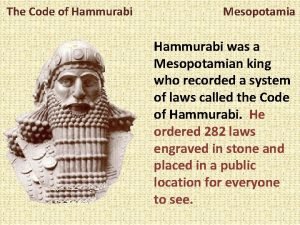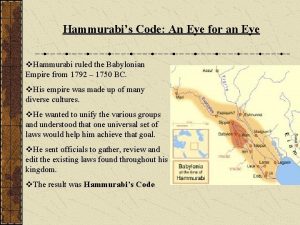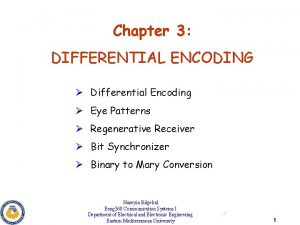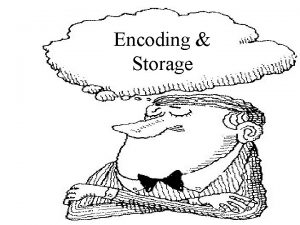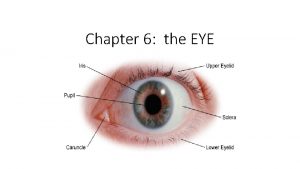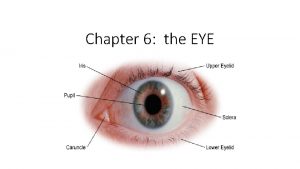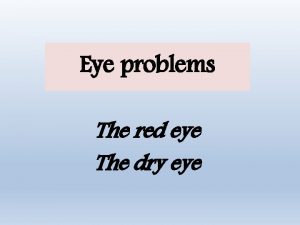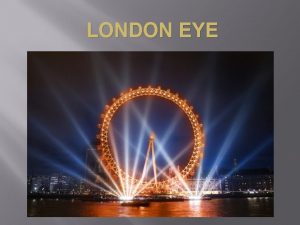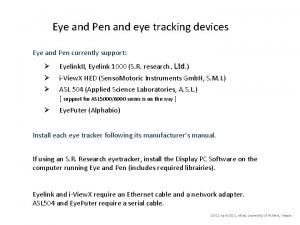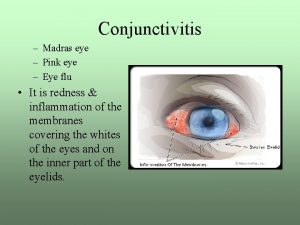Chapter 3 DIFFERENTIAL ENCODING Differential Encoding Eye Patterns












- Slides: 12

Chapter 3: DIFFERENTIAL ENCODING Ø Differential Encoding Ø Eye Patterns Ø Regenerative Receiver Ø Bit Synchronizer Ø Binary to Mary Conversion Huseyin Bilgekul Eeng 360 Communication Systems I Department of Electrical and Electronic Engineering Eastern Mediterranean University 1

Differential Coding System Ø Differential encoding removes the problem of Unintentional Signal Inversion. Ø Polarity of the differentially encoded signal may be inverted without affecting the decoded signal. Modulo-2 addition Exclusive OR I 1 I 2 Out 0 0 1 1 1 0 2

Example of Differential Coding Encoding Input sequence dn Encoded sequence en 1 1 1 0 0 1 0 1 1 0 0 0 1 1 1 0 0 1 1 1 0 1 0 0 1 Reference digit Decoding (with correct channel polarity) Receiver sequence 1 (Correct polarity) Decoded sequence Decoding (with inverted channel polarity) Received sequence 0 (Inverted polarity) Decoded sequence Ø Decoded sequence is same whethere is inversion or not. EEE 360 3

Eye patterns Ø The effects of channel filtering and channel noise can be seen by observing the received line code on an oscilloscope. Received Line Code Information from Eye Pattern • Timing error Eye opening • Sensitivity Slope of the open eye • Noise Margin height of the eye opening 4

Regenerative Repeater Ø Regenerate a noise-free digital signal. Amplify and clean-up the signal periodically Increases the amplitude Minimize the effect of channel noise & ISI Produces a sample value Produces a high level o/p if sample value>VT Generates a clocking signal 5

Synchronization Ø Synchronization signals are clock-type signals necessary within a receiver for detection of data from the corrupted input signal. Ø Digital communications need at least 3 types of synchronization signals. • Bit Synchronization (Bit Synch. ): To distinguish bit intervals. • Frame Synchronization (Frame Synch. ): To distinguish groups of bits. • Carrier Synchronization: For bandpass signals with coherent detection. Ø Sync signals are derived from • Corrupted input signal. • From a separate channel that transmits sync signals. 6

Bit Synchronizer for NRZ Signals Ø Derive the synch signal from the corrupted received signal. Ø Used for unipolar NRZ signals. Ø Synchronizer complexity depends on the line code used. Ø Synchronizarion of RZ signals is easier since PSD has delta at f=R=1/Tb. Ø Bit synchronizer for NRZ signals is given below. 7

Square-law Bit Synchronizer for NRZ Signals • Square Law Device converts polar NRZ signal to unipolar RZ format. • Unipolar RZ signals have delta in the PSD at f=R=1/Tb. • This frequency component can be obtained by filtering. • Filtered sinusoidal is converted to clock pulses using a comparator. 8

Binary-to-multilevel polar NRZ Signal Conversion Ø Binary to multilevel conversion is used to reduce the bandwidth required by the binary signaling. • Multiple bits (l number of bits) are converted into words having SYMBOL durations Ts=l. Tb where the Symbol Rate or the BAUD Rate D=1/Ts=1/l. Tb. • The symbols are converted to a L level (L=2 l ) multilevel signal using a l-bit DAC. • Note that now the Baud rate is reduced by l times the Bit rate R (D=R/l). • Thus the bandwidth required is reduced by l times. Ts: Symbol Duration L: Number of M ary levels Tb: Bit Duration l: Bits per Symbol L=2 l D=1/Ts=1/l. Tb=R/l Bnull=R/l 9

Power Spectra for Multilevel Polar NRZ Signals (c) L = 8 = 23 Level Polar NRZ Waveform Out 10

Spectral Efficiency Ø The Spectral efficiency of a digital signal is given by, where R is the data rate and B is the bandwidth required. • If limited BW is desired, then use a signaling technique that has high spectral efficiency. • Maximum spectral efficiency (which is limited by channel noise) is given by the Shannon’s Channel Capacity formula: Spectral efficiency for multilevel signaling is 11

PSD of a multilevel polar NRZ waveform I R (k ) = å (an an + k )i Pi i =1 PSD for a multilevel polar NRZ signal: Ps(f) Ø Multilevel signaling is used to reduce the BW of a digital signal 12
 Basic coding test
Basic coding test Integral manchester encoding
Integral manchester encoding Eye for an eye code
Eye for an eye code Ant birds eye view
Ant birds eye view An eye for an eye hammurabi
An eye for an eye hammurabi Anemia eyes vs normal
Anemia eyes vs normal Hammurabi code an eye for an eye
Hammurabi code an eye for an eye An eye for an eye a tooth for a tooth sister act
An eye for an eye a tooth for a tooth sister act Brown eye blue eye genetics chart
Brown eye blue eye genetics chart An eye for an eye meaning
An eye for an eye meaning Behold he is coming
Behold he is coming Differential diagnosis red eye
Differential diagnosis red eye In traditional dating patterns dating behavior
In traditional dating patterns dating behavior


